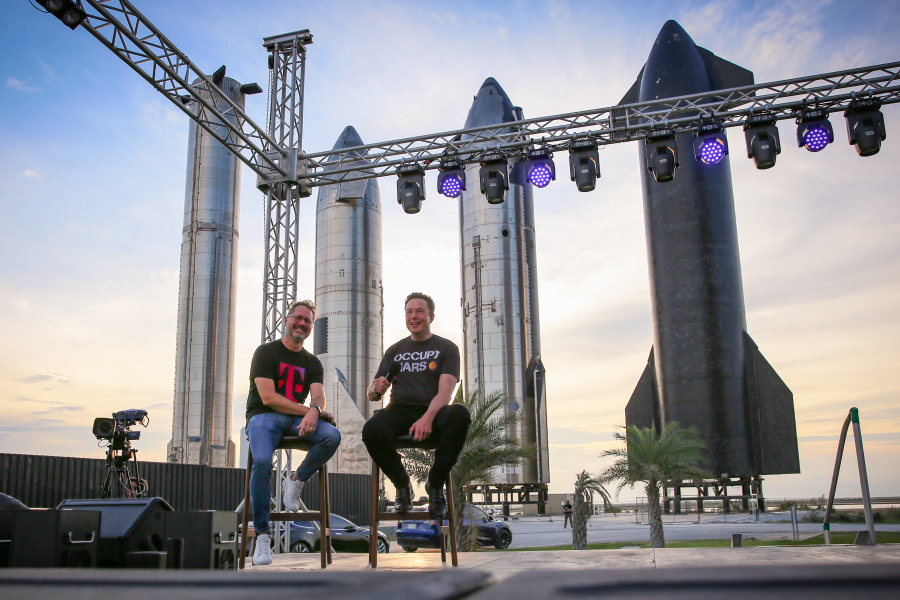T-Mobile, SpaceX unveil plans to ‘end dead zones’ and ‘save lives’ with satellite-direct-to-phone tech
T-Mobile yesterday announced plans to leverage SpaceX low-earth-orbit (LEO) satellites deliver a lower-bandwidth service to existing cellular devices that is designed to eliminate most outdoor coverage gaps and provide a redundant path to deliver calls when terrestrial networks are incapacitated by a natural disaster.
“This partnership has a vision that is the end of mobile dead zones,” T-Mobile CEO and President Mike Sievert said during an event about the SpaceX collaboration. When the vision is fully realized, “if you have a clear view of the sky, you are connected on your mobile phone.”
SpaceX Chief Engineer Elon Musk echoed this sentiment.
“Even if all the cell towers were taken out, your phone would still work,” Musk said during the event.
This capability has significant safety implications, particularly for individuals who may be in an emergency situation but today may not be able to call for help, because they are outside the coverage footprint of terrestrial cellular networks.
“We’ve all read about people who have been hiking or got lost and perhaps died of thirst or exposure or someone who got stuck in a blizzard and froze to death,” Musk said during the event. “You could conceivably get stranded on a desert island.
“But now, you can call for help. The thing that I think is really profound about what we’re announcing today is that it will save lives. We will no longer read about these tragedies where people got lost, and if only they could’ve called for help, they would be OK. So, what I think what we’re doing here is profound. It’s going to vastly improve people’s convenience, and it’s going to save lives. It’s incredible.”
Musk emphasized that the new capability is designed to work with existing cellular devices, because the SpaceX LEO satellites—the Starlink second-generation satellites—would emulate traditional cell towers, but would do so from space.
“Certainly if you’re walking outside or you pull your cell phone out, it will work great,” Musk said. “But we think that even [if the device] is in your pocket or in your car, it will work well.”
This satellite-direct-to-cell-phone technology should not be considered as a replacement for terrestrial networks, because a satellite cell—a much larger coverage area than the footprint of a terrestrial cell—is expected to deliver between 2 Mbps to 4 Mbps in throughput that would be shared with all users in the satellite cell, according to Musk.
“This won’t have the kind of bandwidth that a Starlink terminal would have, but it will enable texting, and it will enable images [to be transmitted],” he said. “And if there aren’t too many people in the [satellite] cell zone, you could potentially have a little bit of video.
“The important thing about this is that it means that there are no dead zones anywhere in the world for your cell phone. We’re incredibly excited to do this with T-Mobile.”
Sievert said this satellite-to-phone connectivity would be delivered over the carrier’s nationwide PCS spectrum.
These airwaves in the 1.9 GHz band are used commonly in cellular system, but they are much higher than the sub-1 GHz frequencies being targeted initially by companies like Lynk Global and AST SpaceMobile, two of the pioneer players in the satellite-direct-to-phone space.
Even with the less-favorable signal-propagation characteristics of the T-Mobile spectrum, SpaceX engineers “have it working in the lab,” according to Musk. However, the system works only with a new generation of Starlink satellites that are much larger—25 square meters, with some reports saying they will be more than four times heavier—than existing Starlink satellites.
“To make this work, you have to very big ears—very big, powerful antennas on the satellite,” Musk said.
Sievert noted that yesterday’s event was to announce the SpaceX collaboration, not launch a product. However, T-Mobile hopes to begin beta tests of the new satellite service by the end of next year, and initial discussions have contemplated offering the satellite coverage for free within higher-tier rate plans and as an adjunct offering to lower-cost rate plans, he said.
T-Mobile’s announcement with SpaceX represents a high-profile step for the notion that LEO satellites could act as cellular towers to provide some level of connectivity to most outdoor locations.
Lynk Global and AST SpaceMobile have made considerable progress in this domain—even announcing relationships with numerous commercial wireless carriers—but a notable amount of skepticism in the technology has remained in some parts of the industry about its viability of such offerings.
At the heart of most skeptics’ arguments have been questions about how a typical cell phone transmitting at 0.200 watts could have its signal heard by a LEO satellite that is more than 300 miles above the surface of the earth. However, Lynk and AST SpaceMobile have conducted field test that indicate that such connectivity is possible. The fact that T-Mobile and SpaceX are making such a high-profile announcement about their satellite-to-phone plans on spectrum that has much worse signal propagation would seem to reinforce the idea that sub-1 GHz connection to a LEO satellite could be fairly robust.
A notion offered privately by several industry sources during the recent APCO 2022 event is that the link budget between a LEO satellite and a device operating on the 700 MHz Band 14 spectrum licensed to the FirstNet Authority could be particularly strong, because Band 14 uniquely permits high-power user equipment (HPUE) devices to transmit at 1.25 watts—more than six times the power of normal cell phone. AT&T plans to conduct tests with AST SpaceMobile on Band 14 spectrum, but it is not clear whether HPUE-driven solutions would be utilized in those satellite-direct-to-phone tests.
Public-safety officials generally have declined to say much publicly about satellite-direct-to-phone technology until they see it operate successfully in real-world settings. However, if the technology is proven to work, most agree that it could have a significant impact on public-safety operations, as it should largely answer key questions about resiliency and outdoor coverage in the face of widescale natural disasters.
In particularly, one of the biggest problems that public safety and other critical-infrastructure entities have with push-to-talk-over-cellular technologies is the fact that it does not support long-range communications between devices that lack a terrestrial-network connection, largely because of the limited power of broadband handsets. But an effective satellite-direct-to-phone service theoretically should provide a reliable solution with even greater range than land-mobile-radio (LMR) technology, at least in outdoor settings.


















Now here is something useful. So many parts of the country have no radio or cellphone coverage. If this is not too expensive it would really make a difference!